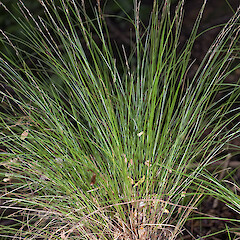Carex banksiana
Common name
fine-leaved bastard grass
Synonyms
Uncinia banksii Boott; Uncinia riparia R.Br. var. banksii (Boott) C.B.Clarke; Uncinia capillaris Col.
Family
Cyperaceae
Flora category
Vascular – Native
Endemic taxon
Yes
Endemic genus
No
Endemic family
No
Structural class
Sedges
NVS code
The National Vegetation Survey (NVS) Databank is a physical archive and electronic databank containing records of over 94,000 vegetation survey plots - including data from over 19,000 permanent plots. NVS maintains a standard set of species code abbreviations that correspond to standard scientific plant names from the Ngä Tipu o Aotearoa - New Zealand Plants database.
UNCBAN
Chromosome number
2n = 88
Current conservation status
The conservation status of all known New Zealand vascular plant taxa at the rank of species and below were reassessed in 2017 using the New Zealand Threat Classification System (NZTCS) – more information about this can be found on the NZTCS website. This report includes a statistical summary and brief notes on changes since 2012 and replaces all previous NZTCS lists for vascular plants.
Please note, threat classifications are often suggested by authors when publications fall between NZTCS assessment periods – an interim threat classification status has not been assessed by the NZTCS panel.
- Conservation status of New Zealand indigenous vascular plants, 2017 . 2018. Peter J. de Lange, Jeremy R. Rolfe, John W. Barkla, Shannel P. Courtney, Paul D. Champion, Leon R. Perrie, Sarah M. Beadel, Kerry A. Ford, Ilse Breitwieser, Ines Schönberger, Rowan Hindmarsh-Walls, Peter B. Heenan and Kate Ladley. Department of Conservation. Source: NZTCS and licensed by DOC for reuse under the Creative Commons Attribution 4.0 International licence.
2017 | Not Threatened
Previous conservation statuses
2012 | Not Threatened
2009 | Not Threatened
2004 | Not Threatened
Distribution
Endemic. New Zealand: North Island (Te Paki to the southern Waikato and Bay of Plenty, thence mostly in west to about Wellington), South Island (North-West Nelson, Marlborough Sounds, Canterbury and Otago).
Habitat
Next to Carex uncinata Linn.f. one of the most common species of northern coastal and lowland forest and scrub.
Detailed description
Densely tufted, bright green to blue-green plants. Culms 100–350 mm long, much < 0.5 mm diameter, glabrous, terete; basal bracts dull reddish brown. Leaves 3–6 per culm, = or > culm, 0.5–1.5 mm wide, very soft, harshly scabrid on margins and upper surface towards the long filiform tip. Spikes 30–70 × 1–2 mm, occasionally bracteate, female flowers c. 5–10, all distant, internodes 1–10 mm. long, male glumes scarcely imbricating. Glumes much < utricles, deciduous, ovate or oblong, acute or acuminate, hyaline with a green midrib. Utricles 4.5–6 mm long, slightly < 1 mm diameter, plano-convex or terete, narrow-lanceolate or oblong, strongly nerved, rarely smooth, green to very pale brown, not spreading at maturity, distinctly contracted to a stipe 0.5–1.0 mm long, beak 1.0–1.5 mm long.
Similar taxa
Very large specimens of Carex banksiana could be confused with C. hamlinii K.A.Ford, however C. hamlinii usually grows in cooler habitats away from the coast or at higher elevations than C. banksiana, and both species have yet to be found growing sympatrically. From C. hamlinii, C. banksiana differs by its smaller stature, by the glumes which are hardly overlapping and by the more distant female flowers. C. subviridis K.A.Ford, another fine-leaved species has a superficial resemblance to C. banksiana. Both species have a similar gracile growth habit, and rather fine light-green leaves and lax inflorescences. However, Carex subviridis is a larger plant closer set flowers, and with scabrid rather than glabrous utricles.
Flowering
October–November
Fruiting
November–April (but old inflorescences present throughout the year)
Propagation technique
Easily grown from fresh seed and by division of established plants. Does best in a free draining soil, in a semi-shaded site.
Etymology
carex: Latin name for a species of sedge, now applied to the whole group.
banksiana: Named after Sir Joseph Banks, 1st Baronet, GCB, PRS (24 February 1743 - 19 June 1820) was an English naturalist, botanist and patron of the natural sciences.
Attribution
Description adapted from Moore and Edgar (1970). Fact sheet prepared by Peter J. de Lange 17 August 2006.
References and further reading
Moore LB, Edgar E. 1970. Flora of New Zealand, Volume II. Indigenous Tracheophyta: Monocotyledones except Gramineae. Government Printer, Wellington, NZ. 354 p.
NZPCN Fact Sheet citation
Please cite as: de Lange, P.J. (Year at time of access): Carex banksiana Fact Sheet (content continuously updated). New Zealand Plant Conservation Network. https://www.nzpcn.org.nz/flora/species/carex-banksiana/ (Date website was queried)






